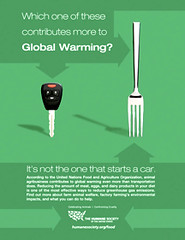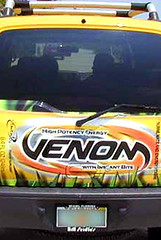As covered by The New York Times, The Humane Society and PETA have taken an interesting position on global warming: Hummers are good; hamburgers are bad.
"Environmentalists are still pointing their fingers at Hummers and S.U.V.’s when they should be pointing at the dinner plate,” said Matt A. Prescott, manager of vegan campaigns for PETA, who said PETA is outfitting a Hummer with a driver in a chicken suit and a vinyl banner proclaiming meat as the top cause of global warming.
While the Humane Society is placing its faith in a United Nations Food and Agriculture Organization report that claimed the livestock business generates more greenhouse gas emissions than all forms of transportation combined, we might point out one obvious flaw — it's not the eaten animals that are contributing to greenhouse gases.
There are others. Disrupting the habitats of animals to drill for oil might qualify as hypocrisy. Alienating increasingly environmentally-conscious consumers by stating they “cannot be a meat-eating environmentalist” seems counterproductive. And promoting the concept of choosing the lesser of two evils seems, well, off the ranch.
While the ad might work in achieving some media buzz for its B-grade shock value, it has no strategic merit. If anything, all it really does is reinforce what critics has been saying for years: they don't care about doing right as much as being right. (In the article, Prescott all but said they are counting on critics to make this ad an issue.)
And that's too bad. Given that 87 percent of those surveyed in one recent study said they are seriously concerned about the environment (though not necessarily ready to give up meat and SUVs), the timing couldn't be worse. Why? Because crackpot creative might get some publicity, but it's often at the expense of credibility.

"Environmentalists are still pointing their fingers at Hummers and S.U.V.’s when they should be pointing at the dinner plate,” said Matt A. Prescott, manager of vegan campaigns for PETA, who said PETA is outfitting a Hummer with a driver in a chicken suit and a vinyl banner proclaiming meat as the top cause of global warming.
While the Humane Society is placing its faith in a United Nations Food and Agriculture Organization report that claimed the livestock business generates more greenhouse gas emissions than all forms of transportation combined, we might point out one obvious flaw — it's not the eaten animals that are contributing to greenhouse gases.
There are others. Disrupting the habitats of animals to drill for oil might qualify as hypocrisy. Alienating increasingly environmentally-conscious consumers by stating they “cannot be a meat-eating environmentalist” seems counterproductive. And promoting the concept of choosing the lesser of two evils seems, well, off the ranch.
While the ad might work in achieving some media buzz for its B-grade shock value, it has no strategic merit. If anything, all it really does is reinforce what critics has been saying for years: they don't care about doing right as much as being right. (In the article, Prescott all but said they are counting on critics to make this ad an issue.)
And that's too bad. Given that 87 percent of those surveyed in one recent study said they are seriously concerned about the environment (though not necessarily ready to give up meat and SUVs), the timing couldn't be worse. Why? Because crackpot creative might get some publicity, but it's often at the expense of credibility.

















